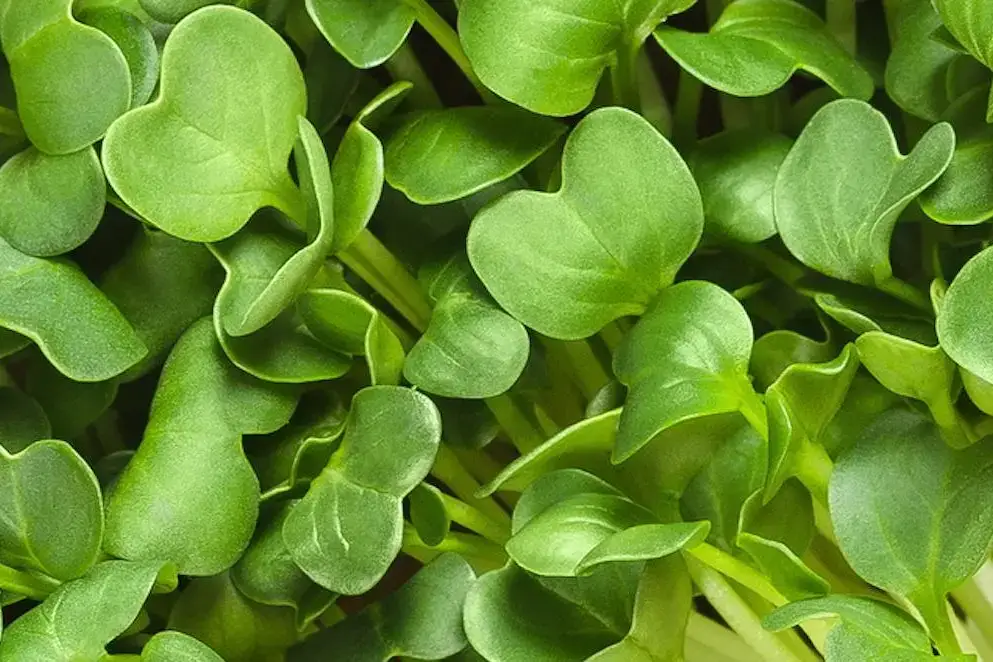Radish Microgreen Nutrition Fact Sheet

Radish microgreens belong to the Brassicae family, to which broccoli, cauliflower and Brucella sprouts also belong. They have a somewhat spicy taste and are delicious when consumed in salads, smoothies, as a topping on hot dishes, with hamburgers, etc. But the versatility of consumption is not their only benefit. These tiny seedlings are loaded with essential nutrients.
Nutrition Profile
Radish microgreens provide low calories, are rich in fiber, and in addition, are a source of various vitamins, minerals, and antioxidants responsible for their properties. In radish microgreens, especially those of the green daikon variety, we find:
Vitamin C: it is essential to produce collagen and plays a fundamental role as an antioxidant. That is why radish microgreens are an excellent choice for maintaining skin health. Collagen is essential for maintaining skin elasticity and smoothness. On the other hand, vitamin C is essential for fighting free radicals associated with aging and can stimulate and maintain the health of the immune system. Radish microgreens can be an ideal choice to strengthen defenses.
Vitamin A: it is involved in eye and skin health. It complements the action of vitamin C and also strengthens the immune system. Radish microgreens provide carotenoids, that is, the inactive form of vitamin A. Therefore, it is essential to have good liver function to take advantage of all these virtues. After being activated, vitamin A regulates gene expression and plays a fundamental role in growth and development.
Vitamin E: is a great antioxidant and enhances the action of omega-3 fats, protecting them against oxidation and helping them to exert their anti-inflammatory and cardiovascular protective action. Vitamin E has been shown to be an excellent reliever of menstrual pain and cramps in women with dysmenorrhea. This effect is enhanced when consumed together with omega-3 fatty acids of animal origin.
In addition, radish microgreens contain several essential minerals, which are responsible for providing numerous health properties:
Magnesium: essential in over 300 organic reactions. Most people are deficient in this mineral. However, they do not know it. Magnesium is essential in the production of energy and in the health of bones and joints. It is also needed for the transmission of nerve impulses.
Calcium: not only is it essential for bone health but it is also involved in muscle contraction and cardiovascular health.
Potassium: is the principal intracellular cation that helps regulate the amount of fluid. It regulates nerve signaling and helps regulate electrolyte water balance. It also helps regulate blood pressure.
Iron: although it is present in horseradish microgreens, its chemical form has low absorption. For this reason, it is recommended to be supplemented with a source of vitamin C, such as peppers, tomatoes, citrus fruits, strawberries, etc.
Finally, radish microgreens are rich in compounds that break down into isothiocyanates when they come into contact with water. These plant compounds have tremendous anticarcinogenic power, preventing the formation of tumors.
This nutritional contribution makes radish microgreens ideal for supplementing the diet of people with fatigue, weight gain, fluid retention problems, high cholesterol, muscle weakness, high blood pressure, and for cancer prevention.
References:
Lorenzana Rodríguez, S. (2020). Funciones de la vitamina A y disfunciones relacionadas con su carencia. From: https://uvadoc.uva.es/handle/10324/42180
Febles Fernández, C., Soto Febles, C., Saldaña Bernabeu, A., & García Triana, B. E. (2002). Funciones de la vitamina E: Actualización. Revista Cubana de Estomatologia, 39(1), 28–32. From: http://scielo.sld.cu/scielo.php?script=sci_arttext&pid=S0034-75072002000100005
Isothiocyanates. (2014, April 29). Linus Pauling Institute. From: https://lpi.oregonstate.edu/mic/dietary-factors/phytochemicals/isothiocyanates
Tuero, B. B. (2000). FUNCIONES DE LA VITAMINA C EN EL METABOLISMO DEL COL¡GENO. Ihmc.Us. From: https://cmapspublic3.ihmc.us/rid=1GQ861HNG-L3S88S-LKM/VITAMINAS%20PDF.pdf
(N.d.-a). Isu.edu. Retrieved March 8, 2023, from https://www.isu.edu/media/libraries/rural-health/microgreens/Microgreen-Nutritional-Profile.pdf
Manivannan, A., Kim, J. H., Kim, D. S., Lee, E. S., & Lee, H. E. (2019). Deciphering the Nutraceutical Potential of Raphanus sativus-A Comprehensive Overview. Nutrients, 11(2), 402. https://doi.org/10.3390/nu11020402
Disclaimer: The information provided in this article is for educational and informational purposes only and is not intended as medical advice. It is not a substitute for professional medical advice, diagnosis, or treatment. Always seek the advice of a qualified healthcare provider with any questions you may have regarding a medical condition. The author and publisher of this article are not responsible for any adverse effects or consequences resulting from the use of any suggestions, preparations, or procedures described in this article.

